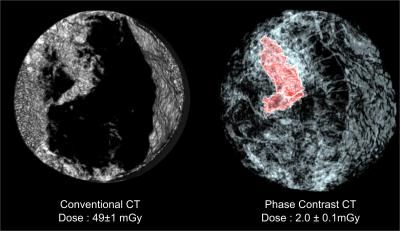Novel Breast CT Provides Higher Resolution, Lower Dose
A new method using 3D CT in breast imaging provides a resolution two to three times higher with a radiation dose about 25 times lower.
A new method using three-dimensional diagnostic CT in breast imaging provides a spatial resolution two to three times higher than current hospital scanners, but with a radiation dose that is about 25 times lower, according to a study published online in the early edition of the Proceedings of the National Academy of Sciences (PNAS).
Breast screening usually involves dual-view digital mammography, which provides two images of the breast tissue. Traditional CTs that can provide 3D images are not routinely used because of the increased risk associated with radiation exposure. For this reason, researchers from France, Germany, and the United States studied the effectiveness of a new technique that combined high energy X-rays, a special detection method called phase contrast imaging, and the use of a sophisticated novel mathematical algorithm known as equally sloped tomography (EST), to reconstruct CT images from X-ray data.
Since tissues are more transparent to high-energy X-rays, lower doses are deposited into the breast tissue, with a noted reduction in radiation dose to a factor of six. Phase contrast imaging allows image production to use much fewer X-rays to obtain the same image contrast and the EST method requires four times less radiation to obtain the same image quality.
For the study, the researchers performed X-rays on a human breast at multiple different angles, using phase contrast tomography, and they applied the EST algorithm on 512 images to produce higher resolution 3D images.
Five independent radiologists assessed and ranked the generated images, looking at highest sharpness, contrast, and overall image quality compared with traditional 3D breast tissue images.
According to Prof. Maximillian Reiser, radiology department director at the Ludwig Maximillians University in Munich, “This new technique can open up the doors to the clinical use of computed tomography in the breast diagnosis, which would be a powerful tool to fight even better and earlier against breast cancer.”
This technology is not yet available to the public as more research is needed to find an X-ray source small enough to become commonly used for breast cancer screening. “Many research groups are actively working to develop this device and once this hurdle is cleared, the new X-ray technique is poised to make a big impact on society,” said Emmanuel Brun, one of the study’s authors.

This is a comparison between a conventional CT scan of the breast sample and a scan using equally sloped tomography with phase contrast imaging. In the latter image, the tumor is highlighted in red. The radiation dose needed for the scans is indicated at the bottom. (Credit: ESRF-LMU/Brun)
Study Shows No Impact of Hormone Therapy on PET/CT with 18F-Piflufolastat in PCa Imaging
May 7th 2025For patients with recurrent or metastatic prostate cancer, new research findings showed no significant difference in the sensitivity of 18F-piflufolastat PET/CT between patients on concurrent hormone therapy and those without hormone therapy.